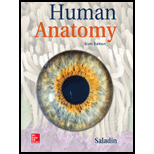
Components of the skeletal system, including but not limited to the bones
To determine:
The components of skeletal system.
Introduction:
The skeletal system provides the overall structure to the body. The bones, cartilages, ligaments and tendons make up the skeletal system. The ligaments are the structures that join two bones together. The tendons join the muscles to the bones. The foremost functions of the skeletal system are to provide physical support and to protect inner delicate organs of the body.
Answer to Problem 6.1.1AYLO
The components of skeletal system are cartilage, tendons, joints and ligaments.
Explanation of Solution
The skeletal system is the system that provides shape, structure, protection to the body. It also plays a major part in the maintenance of the electrolyte balance of the body. The blood cell lineages are also produced by the hematopoietic cells present in the bone marrow of the bones. The movement and locomotion of the body is possible only by the virtue of bones in the body.
The skeletal system is mainly made up of bones but other than the bones there are components like;
- Cartilage:
The cells that make up the cartilage are known as the chondrocytes. The chondrocytes together form the fibrous connective tissue in integration with the gelatinous matrix called chondrin. The presence of this rubbery gelatinous matrix makes the cartilage very flexible and this flexibility support the structures like nose, ears, trachea etc. There are three kinds of cartilage: hyaline cartilage that forms bone, fibrous cartilage that is present in the joint capsules and elastic cartilage that are found in the external ear.
- Tendons:
Tendons are also the fibrous connective tissue that connects bone to the muscle. The property to withstand tension is the characteristic feature of a tendon.
- Joints:
The portion of the body where two skeletal structures especially the bones join is known as a joint. The joints usually facilitate the movement of the bones. According to the structures, the joints can be divided as the fibrous, synovial and cartilaginous joints. The functional classifications of the joints include the immovable joints, slightly movable joints and the freely movable joints.
- Ligaments:
The structures that join bone to a bone are called as the ligaments. These are also a form of fibrous connective tissue.
Thus, the above mentioned components are the components of the skeletal system other than the bones.
Thus, the components of skeletal system are cartilage, tendons, joints and ligaments.
Want to see more full solutions like this?
Chapter 6 Solutions
HUMAN ANATOMY
- What is behavioral adaptarrow_forward22. Which of the following mutant proteins is expected to have a dominant negative effect when over- expressed in normal cells? a. mutant PI3-kinase that lacks the SH2 domain but retains the kinase function b. mutant Grb2 protein that cannot bind to RTK c. mutant RTK that lacks the extracellular domain d. mutant PDK that has the PH domain but lost the kinase function e. all of the abovearrow_forwardWhat is the label ?arrow_forward
- Can you described the image? Can you explain the question as well their answer and how to get to an answer to an problem like this?arrow_forwardglg 112 mid unit assignment Identifying melting processesarrow_forwardGive only the mode of inheritance consistent with all three pedigrees and only two reasons that support this, nothing more, (it shouldn't take too long)arrow_forward
- Oarrow_forwardDescribe the principle of homeostasis.arrow_forwardExplain how the hormones of the glands listed below travel around the body to target organs and tissues : Pituitary gland Hypothalamus Thyroid Parathyroid Adrenal Pineal Pancreas(islets of langerhans) Gonads (testes and ovaries) Placentaarrow_forward
- Understanding Health Insurance: A Guide to Billin...Health & NutritionISBN:9781337679480Author:GREENPublisher:Cengage
 Human Physiology: From Cells to Systems (MindTap ...BiologyISBN:9781285866932Author:Lauralee SherwoodPublisher:Cengage Learning
Human Physiology: From Cells to Systems (MindTap ...BiologyISBN:9781285866932Author:Lauralee SherwoodPublisher:Cengage Learning Human Biology (MindTap Course List)BiologyISBN:9781305112100Author:Cecie Starr, Beverly McMillanPublisher:Cengage Learning
Human Biology (MindTap Course List)BiologyISBN:9781305112100Author:Cecie Starr, Beverly McMillanPublisher:Cengage Learning Medical Terminology for Health Professions, Spira...Health & NutritionISBN:9781305634350Author:Ann Ehrlich, Carol L. Schroeder, Laura Ehrlich, Katrina A. SchroederPublisher:Cengage Learning
Medical Terminology for Health Professions, Spira...Health & NutritionISBN:9781305634350Author:Ann Ehrlich, Carol L. Schroeder, Laura Ehrlich, Katrina A. SchroederPublisher:Cengage Learning





